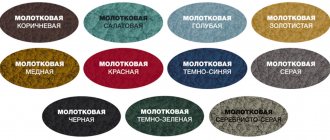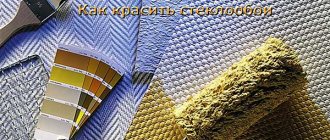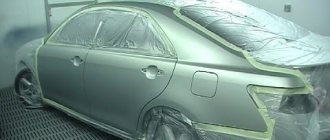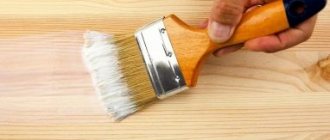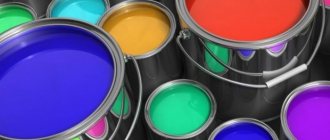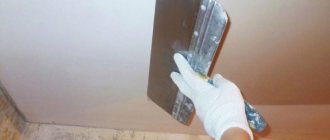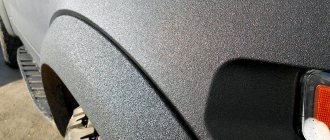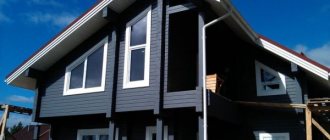Sometimes when remodeling furniture the question arises of how to paint chipboard. This material is one of the most common materials for making furniture; it is also used in construction and renovation work. Chipboard (chipboard) has been used in various fields for decades, furniture made from this material is especially common.
Chipboard consists of wood chips glued together with formaldehyde resin. Since wood chips can become unstuck under external influences, they are protected with an outer coating - this can be a layer of varnish, paint, polypropylene film, etc. In addition to protection, painting chipboard also creates a decorative effect, since this method can create surfaces not only of different colors, but also with different textures.
To restore the attractive appearance of chipboard, it is enough to update the paint layer, thanks to which products made from this material acquire their own unique style. Also, painting chipboard increases its moisture protection and makes the material resistant to ultraviolet rays. When painting work is carried out correctly, old furniture and other chipboard products not only get a new look, but also extend their service life. Also, coating chipboard with paint reduces its impact on humans (over time, resins tend to evaporate, and paint prevents this process).
An important point is what the chipboard is coated with on top - varnish. There is no veneer, paint, film or coating. Of all the options listed, laminate is the most difficult to paint over. It must be covered with several layers of primer, and no one guarantees the result.
Preparation for painting chipboard
Before you start painting chipboard, you must carefully prepare the surface. The result of staining will depend on the quality of preparation. Usually, to “ennoble” the appearance of chipboard products, they are coated with a layer of varnish or paint, but over time they crack and peel off. Removing varnish or old paint from the surface of furniture often causes difficulties for craftsmen. Of course, this is a long and labor-intensive process, but it is possible to clean surfaces.
To remove a layer of old coating from chipboard, two methods are used:
- Chemical. When the surface is treated with various chemical compounds (washes). They are selected depending on the composition of the old paint. It is necessary to carefully follow the conditions of use indicated on the remover label to avoid trouble.
- Thermal method. In this case, exposure to hot air or steam is used. A construction hair dryer and spatulas (scrapers) are required. A stream of hot air is directed onto the painted surface, and when the paint softens, it is removed with a scraper. It is important to maintain the correct temperature conditions so as not to damage the chipboard.
Also, the surface of the chipboard must be puttied and sanded. This will save the product from minor defects and scratches, which are especially noticeable under a layer of fresh paint.
Before applying the putty, the surface must be primed with a suitable compound. For chipboard, it is better to choose elastic putties, for example, acrylic. This will protect the product from cracks on the surface. Apply the putty using a spatula, trying to form an even layer. After the putty has completely dried, the surface is treated with fine-grained sanding paper. The product is sanded with it until all the irregularities disappear. Then the product should be cleaned of dust, and you can begin painting work.
Main types of wood varnishes
- Oil varnishes initially included only solutions of natural resins. Now they consist of artificial resins and modified natural oils with the addition of solvents and driers. The use of artificial analogues has made it possible to significantly reduce production costs, and therefore the cost of oil paint for wood has become much more affordable. After applying oil varnish to the treated surface of the wood, a durable film of a slightly yellowish color is formed. Oil varnishes are mainly used for finishing floors and performing indoor work.
- For the production of alkyd varnishes on wood, glypthal and pentaphthalic synthetic resins are used, to which driers are added. Despite the fact that these varnishes are sometimes classified as oil-based (since they use synthetic oils as a solvent), their performance characteristics are at a higher level compared to varnishes of the first group.
- You can give the surface high strength and shine using alcohol varnishes and polishes. Such coatings are easy to polish, but they do not provide very high protection against moisture. Alcohol varnishes and polishes, for the production of which natural resins are used, are now produced in small batches. They are mainly used in the manufacturing process of musical instruments.
- Alkyd-urea varnishes consist of solutions of alkyd and amino-formaldehyde resins. To dry such products in air at normal temperatures, it is necessary to add acidic hardeners to their composition. They are added to varnishes before surface treatment begins.
After the hardener is introduced, the varnishes have a limited period of use (depending on the properties of the hardener, it can range from 3-4 hours to 1-2 days). The film formed by such wood products is very hard and wear-resistant. They are used to process parquet, furniture and other interior items used indoors.
- To make nitrocellulose varnish, cellulose nitrate is mixed with various organic solvents. To adjust the properties of this product, resins are added to the composition.
Nitrocellulose varnish creates a hard and durable film, transparent, without any tint. It is used to cover wooden elements and products intended for indoor use.
- Polyester varnishes contain a large number of different components. Its use requires great precision of application. Coating with polyester varnish practically does not shrink; the thick film formed after its application has a high degree of resistance to such negative factors as water and various reagents.
- For the production of acrylic varnishes, solutions of polyacrylates and organic solvents are used. The film obtained by treating wood with this product has low abrasion resistance. Due to their environmental friendliness, as well as a large selection of wood varnish colors, they are recommended for use in children's rooms.
- Exceptionally high mechanical strength and wear resistance are inherent in polyurethane varnish. They cover floors in palaces and museums, and musical instruments. Its use requires strict adherence to the requirements specified in the instructions. This is the most expensive product for wood, the cost of which is justified by its high performance characteristics.
- Not so long ago they began to produce water-based polyurethane varnishes. They combine the advantages of acrylic and polyurethane varnishes, such as high abrasion resistance and environmental friendliness. And if you use a product with strengthening additives, its service life will increase significantly.
Paints for chipboard
To paint chipboard, the best option would be to use a spray gun or spray paint. This will give a smooth surface without smudges, but it is better to practice first, especially if you have not used a spray gun or aerosol paints before.
As for the types of paint, you can use alkyd, oil or acrylic paints. With different types of paint, the coloring result will also differ. You can paint with a brush or short-haired roller, and in the latter option the uniformity of coloring will be better. After painting, you can coat the product with varnish, this will increase its resistance to mechanical stress.
Purpose
Furniture varnish is a film-forming composition intended for the treatment of wooden bases. It is designed to perform the following tasks:
- protect surfaces from mechanical influences;
- make wooden products glossy (shiny) or matte;
- emphasize the natural beauty of wood (especially valuable species);
- create an impenetrable barrier to moisture, which can cause the wood to dry out or swell;
- protect from biological influences (fungus or harmful insects);
- increase the service life of expensive wooden furniture.
Varnishes for wooden furniture can be slightly tinted by adding pigment, or a transparent version can be used. They must be applied in several layers to ensure reliable protection.
Chipboard painting technology
- The surface is cleaned of dust, dirt and degreased.
- Using coarse sandpaper, clean the surface so that scratches remain - this is done for better adhesion of the primer to the surface.
- Apply a primer (you can use alkyd or even automotive primer for bumpers).
- Next, apply an acrylic primer.
- Paint the surface with the chosen paint with a roller or brush in several layers (at least two). In general, the number of layers depends on the desired end result - some people need a translucent coating, while others need a rich, dense color.
- If after applying the first layer unevenness appears, then it is necessary to sand the surface again with fine-grained sandpaper and apply several more layers of paint.
- Before painting, chipboard products must be treated in such a way that the glue in the sawdust stops evaporating harmful substances and the surface does not absorb moisture. This is achieved by deep penetration impregnations. You can also use NC varnish, but impregnations are more harmless.
- Before varnishing chipboard, it must also be treated with deep penetration impregnation.
- To highlight the wood texture, chipboard can be treated with alkyd pigments or English patination (a special composition for patination and texture highlighting).
- To achieve a smooth painted surface, it is necessary to use rollers with short naps, since long naps leave a pattern. By the way, this is how you can achieve the appearance of texture on a painted surface.
- If you need to paint dark-colored chipboard furniture, it is better to cover the surface with two layers of dense primer, otherwise the dark shade will still be visible through a layer of fresh light paint.
If you decide to renovate an old or paint a new untreated surface, you need to approach the issue carefully and purchase everything you need in advance.
But even before going to the store, you need to decide what you want to get in the end - a glossy or matte surface, plain or multi-colored, will you use any techniques (for example) or will it just be tinted to look like stained oak, wenge or teak . And after that, you need to find out what paint can be used to paint chipboard furniture.
Choosing paint for chipboard furniture
You can’t buy the first paint you come across; you need to choose it carefully. Cheap paints PF-115 containing lead will undermine the health of household members. If you take oil paint, choose a trusted manufacturer: Tex, Rastsvet, Dyo, Yaroslavl paints, Dulux, Tikkurila.
Furniture enamels and varnishes from Novbytkhim, Raduga and Galamix are also applicable in this case. You can paint chipboard furniture with water-based acrylic paint or alkyd enamels. By the way, here the choice is wider due to the aerosol form. Aerosols allow you to obtain perfectly smooth surfaces without smudges. They can be applied to laminated chipboard. Choose acrylic paints from such manufacturers as OLIMP, Parade, Ceresit, Triora.
Acrylic paint for chipboard furniture is the best option because it is completely odorless, can be diluted with plain water, is easy to work with, dries quickly, and inaccurate strokes can be easily removed with a damp cloth. The coating is waterproof and vapor-proof, non-toxic and beautiful.
Another type is latex paints. They also allow you to get a good protective layer on furniture. However, you do not need to apply them in a thick layer so that it does not peel off over time. Also keep in mind that this composition is sensitive to microorganisms and may develop mold, so it is not the best paint for kitchen furniture made of chipboard.
Alkyd paints do not have this disadvantage, but instead they contain a toxic solvent that is harmful to health. Because of this, it is undesirable to use them in residential premises.
The low cost of chipboard, high performance characteristics, and versatility of use have made them a very popular material. The most common areas of application are furniture production and construction. The main enemy of these slabs is water - the chips increase in volume, the slab swells, warps and crumbles.
Even at the very beginning of production, sawdust and shavings, after drying, are impregnated with formaldehyde resins. After pressing, the surface of the boards is laminated, sometimes even varnished.
But protecting the surface does not prevent the penetration of moisture from the ends through which it enters. Accumulating inside, water gradually begins to penetrate the wood fibers, which leads to the destruction of the slab. Consequently, the ends must first be saved from liquid penetration during operation.
If they are tightly sealed, the service life of the slabs will be much longer.
The photo shows the effects of water on a chipboard countertop.
Why are the ends the starting point for destruction? Yes, because the production of slabs of the required standard sizes, as well as the preparation of pieces of material of different sizes, requires cutting. In this case, the integrity of the wood fibers is compromised.
Thus, chipboard protection from moisture is carried out in three directions:
- impregnation of wood fibers with resins;
- special surface treatment;
- end sealing.
How to choose a good furniture varnish
If you choose the right paint coating for furniture, you can not only improve its appearance, but also extend its service life.
So, it is worth assessing the degree of wear of the product. If a piece of furniture will be subject to heavy loads, then polyurethane varnish will be the best option. If the product is needed for decorative purposes, then the best option would be a water-based product.
Also, do not forget about environmental friendliness and fire resistance. If the product contains a solvent, there will be an unpleasant odor during operation. Also, options that do not contain solvents will be resistant to fire.
If the product consists of one component, this will facilitate the application process. But varnishes made from two components will be more stable during operation.
For expensive wood species such as beech, oak, mahogany, it is better to use a transparent product. Because such wood has a beautiful texture, and tinted options will only hide it. The color composition is ideal for pine, birch or walnut. With the help of tone you can make this breed more stylish.
To hide small imperfections in wood, it is better to use products that have a matte effect. And such a coating will not require special care.
Surface treatment of plates
The front and back surfaces of the slab, as the largest contact areas, without any protection, can pass through and absorb, accordingly, the largest amount of liquid. It would be a good idea to cover these surfaces with something moisture-proof. Some of the methods of such coating are possible only in factory conditions, some are also possible at home.
One of the main methods of protection is lamination. In this case, a melamine film is laid on sanded chipboard at high pressure and high temperature. The essence of this process is not pressing, but the fact that under these conditions the film polymerizes the surface of the slab, becoming one with it.
There is another method that is performed in the factory - laminating. Pressure and heat are also used here, but more gentle. The already hardened film is pressed against the glue-coated slab. If lamination is a chemical process, then laminating is a mechanical process.
Components of laminated chipboard
At home, non-laminated chipboard is often coated with several layers of paint for protection. Before painting, pre-treat the surface:
- dust is carefully swept away and washed off the surface;
- for the first time, the plate is coated with hot drying oil;
- then this is done with cold drying oil until an outer crust forms;
- the top is painted. With any painting method, you must remember that each subsequent layer of paint is applied to the already dried previous one.
There are several other ways to protect yourself from getting wet. For example, a surface that will not be subject to mechanical stress can be protected as follows: rub it with stearin, then heat it with a hairdryer. Let cool and repeat this a couple more times. Or: one part of bitumen varnish is mixed with five parts of drying oil. Coating is carried out twice.
How to treat plywood, chipboard and wood to protect against moisture?
The most susceptible to moisture are the sink, cabinet with dryer, countertop, and furniture near and above the stove.
The taps all start to leak at some point. So, the most potentially dangerous place in the sink is where the faucet crashes into the countertop. This is the point of contact between metal and wood. It is possible not only for the faucet to leak, but also for water to condense at the contact point. Therefore, this place is cleaned and dried with a hairdryer. Next, a layer of PVA glue is applied, after which it dries - silicone. You can use construction sealant, this is also a silicone mass; it even seals window frames against leaks.
The edge not only protects the chipboard from moisture, but also reduces emissions of harmful substances
In the dish cabinet, you should check the presence or absence of a tray: if it is not there, the liquid, flowing to the bottom of the cabinet, will ruin it. For all kitchen furniture where it is possible to get wet, you need to make it a rule: degrease this area and then do not skimp on the sealant.
To seal the seams, it is better to use sanitary silicone of a suitable shade: dark mold spots will not appear on the surface.
Non-laminated edges of the tabletop are covered with connecting or end strips. They come in metal or plastic. The protection is not so great, so the end of the tabletop should first be treated with silicone. Another method of protection is to apply furniture varnish or PVA glue to the cut area. Self-adhesive films or tape offered by the construction market cannot be called reliable protection.
Criterias of choice
When choosing a varnish for furniture, you need to focus on its features. The effect to be achieved is also taken into account. In general, when choosing a coating, the following factors are taken into account:
- safety;
- presence or absence of odor;
- fire resistance.
If you are processing furniture for a children's room, it is better to choose safe processing methods. This includes water-based materials.
Oil varnish for wood will help improve the decorative properties of furniture. If you want to age furnishings, you will need a coating with a craquelure effect.
Sealing chipboard joints on the floor
The difficulty lies in the fact that the slabs on the floor are constantly subjected to significant physical stress; they “play” relative to each other. For this reason, the putty does not want to stick. There are several popular ways to seal such seams.
The seams are covered with epoxy mixed with sawdust. The sawdust is first finely sifted. The composition sets very quickly, so it is not worth preparing a large volume of such putty at once. Such protection serves for a long time and reliably. But the price of epoxy is high, and sealing joints is expensive.
You can replace the epoxy with hot wood glue. You need to mix sawdust in it and go through the seams.
The effect is achieved even greater than with epoxy, since the hot glue penetrates deep inside. This method also saves from moisture, and the joint stops “playing”. True, it is advisable not to walk on such a floor for several days, since wood glue takes a long time to dry.
This method is much cheaper. And if the floor is covered with linoleum on top, then you can completely forget about damage to the chipboards.
You might be interested to know
Application method
The question often arises about how to varnish furniture. There are many methods. One of them is to apply the product to furniture from an aerosol can. You can save money by buying an aerosol, since no additional tools are required (roller, brush, cleaning agent).
The consumption of the traditional method of application is greater than that of spraying. The entire surface is painted evenly, and it takes less time. Another advantage of the aerosol is that you can varnish furniture even in places that are most difficult to reach with a classic brush. Finding such a product is not difficult. Every hardware store has it in its assortment. Furniture varnish in the form of an aerosol is most often used for restoration work. For initial coating, it is better to choose a regular composition.
How can you protect chipboard panels from moisture?
Until now, chipboard has been widely used in repairs. After all, these plates are universal. They are suitable for leveling walls, ceilings, laying dry screed, creating interior partitions, and so on. But, if chipboard is planned to be installed in the kitchen or bathroom, certain measures should be taken to protect it from moisture. What methods are available in this case? The main approaches will be discussed below.
1. Treating chipboard with drying oil
One of the simplest methods is applying drying oil to a chipboard. Most often, this method is used when the particle board is planned to be laid on the floor when creating a rough screed. Drying oil is applied to the main part of the slabs in two layers. Drying oil should be applied to the ends of chipboard boards at least three times, since in these areas it will be absorbed especially intensively.
To increase the moisture resistance of chipboard panels, you can add a little bitumen varnish to the drying oil. 1 part varnish to 5 parts drying oil is enough.
2. Painting chipboards with PVA glue
It will be possible to increase the waterproof performance of the particle board if you coat it with PVA glue. This method is used in almost any situation. That is, a slab treated in this way can be used to level surfaces and install partitions. But you can start work only after the glue has completely dried.
It is advisable that the panels are also processed at least twice. In addition, the adhesive composition can act as a primer, so in the future it will be easier to apply plaster, putty or paint.
Varnish for stone and concrete
Today, these materials are widely used in construction. For a structure to be sound, it needs protection from various external factors. For these purposes, use varnish for concrete and stone. A structure coated with this product will be quite durable, its service life, wear resistance, cold resistance will increase, and it will look elegant in appearance.
The main purpose of varnish is to protect the material and increase its shelf life.
The choice of varnishes is large. They can be grouped according to many indicators. By covering the surface with varnish, you will reliably protect it.
Before choosing a varnish, you need to decide in what conditions the furniture treated with it will be located - with high humidity or there will be a lot of sun.
Chipboard impregnation - odor protection
Pasting chipboard with protective film
Another successful way to protect chipboard from moisture is to stick a special protective film. It not only protects the material from contact with moisture, but additionally improves its appearance. That is, the self-adhesive film also performs a decorative function. The owner just has to choose a suitable sample and stick it correctly. To do this, the panel should be cleaned of dirt and dust, the protective layer should be removed from the film and it should be glued. Special decorative corners with water-resistant qualities are installed at the ends.
Each method has its own advantages. And the owner who manages to do the job correctly will receive chipboard panels that are reliably protected from moisture. Then the finished material can be used for work even in those premises that do not have the most favorable operating conditions.
You can treat the countertop, or rather drink it under the hob, and wash it using metal tape. The effect is simply classy, the countertop will probably age faster.
Parameters and characteristics
The main differences between different types of furniture varnishes can be assessed by their technical characteristics. Here is a comparison table of products:
| Product group name | Dry residue, % | Viscosity | Consumption, g/m sq. | Coating resistance to damage | Price | What material is it applied to? |
| Nitrocellulose | 5-27 | 38-50 | 30-150 | Weak | Low | Wood, veneer |
| Acrylic | 20-45 | 30-80 | 110-150 | Moderate | Average | Wood, veneer, MDF |
| Polyurethane | 25-70 | 40-75 | 80-150 | Strong | High | Wood, veneer, MDF |
| Water based | 25-35 | 30-70 | 80-120 | Moderate | Average | Wood, veneer |
Furniture varnishes, used for decoration and giving finished products an attractive appearance, help to increase their service life. Depending on the main active ingredient, acrylic, aqueous, alkyd, polyurethane, and oil products are distinguished. You need to choose the most suitable product based on the requirements for the strength and environmental friendliness of the coating.
How to protect the legs of laminated chipboard cabinets from moisture?
BUT as always there is a BUT. The material is easily vulnerable, and quite (carefully and carefully) labor-intensive, maybe that’s why we don’t particularly like it among assemblers, or maybe someone doesn’t know. As they say, the eyes fear, but the hands do.
PS the base of the tape is aluminum foil.
———————————————————————————— Drying oils are film-forming paints and varnishes based on processed vegetable oils. The composition of natural drying oils includes exclusively drying vegetable oils (linseed, hemp, sometimes sunflower oil is added) and driers. Drying agents are manganese, cobalt, and lead salts of carboxylic acids that accelerate the drying process. Organic solvents are added to the composition of semi-natural drying oils - white spirit, ski*****, Solovent oil. Oxidized drying oils are obtained by heating linseed or hemp oil to 150-160 degrees, stirring and passing drying agents through them. Such drying oils have greater viscosity, increased durability, shine, and a darker color than natural ones. Compacted drying oils, unlike natural ones, are obtained through longer heat treatment at a temperature of about 300 degrees.
Fungus appears on silicone coatings over time.
Dear visitor! You are in the archive of the old forum on mastergrad.com
Main varieties depending on the effect
Furniture varnish for wood is classified according to a number of characteristics. The first of these is the effect imparted to the treated surface. According to this criterion, glossy, matte, colored and transparent varieties of material can be distinguished.
A feature of a glossy or semi-gloss finish is its special shine and highlighting of the wood structure. This finish lasts a very long time, but does not mask flaws in the base well. Recommended for use in gloomy, shaded rooms to optimize the atmosphere.
How to protect chipboard from water?
| Paul 21 July 2004 16:35:58 | Good afternoon a problem arose - the chipboard frame of the kitchen swelled from leaking. The edges were laminated, but this did not help - I think the technology was broken, or the chipboard was bad. The kitchen manufacturer changed the frame, but to avoid the problem I want to pre-treat the edges. Question - with what? Yesterday I tried to cover it up I used liquid nails to cut the chipboard and place the treated end in a bowl of water - it swelled overnight...:(((Advise which product is best to use for sealing the edges? Good luck Pavel |
| Shadow (Moscow) July 21, 2004 18:06:44 | 2 Paul: Rub the exposed areas with silicone sealant. |
| Shadow (Moscow) July 21, 2004 18:10:32 | 2 Paul: Sorry - by open areas we mean non-laminated areas of the frame. In addition, nothing prevents you from applying that sealant to the laminated edges - the silicone film certainly will not allow water to pass through. |
| Paul 21 July 2004 20:10:49 | 2Shandow: I rubbed silicone sealant on the chipboard countertops (cutout under the sink) - it didn’t hold up well:((. I think it will be even worse on a laminated surface... Here you need something penetrating - I’ll try parquet varnish. I’ll let you know about the results. Good luck Pavel |
| Serg (Samara, Russia) July 22, 2004 01:31:38 | 2Paul: Soak with drying oil several times. Best regards, Sergei |
| Paul July 22, 2004 08:31:15 | The varnish did not help - the sample left in water swelled overnight:(( 2 Serg: Today I’ll try drying oil... Good luck Pavel |
| Shrek (Tomsk) July 22, 2004 10:15:46 | IMHO, if you leave chipboard in water overnight, at least saturate it with something - it will swell. |
| Serg (Samara, Russia) July 23, 2004 00:18:13 | 2Paul: You can apply it heated in a water bath - it will be better absorbed. Best regards, Sergei |
| TriX (SPb) July 23, 2004 11:33:23 | Yeah. And under pressure. Then it's totally cool. But it still won't help much. Chipboard does not soak well. The binder prevents the impregnation from going deeper. And the water is so much that it gets into all the cracks, pores, etc. and delaminates the materials. You can look for hydrophobic mixtures such as liquid silicone. It won't swell under it. But this is not suitable for furniture. |
| Shrek (Tomsk) July 23, 2004 12:45:21 | What else did you think :)… |
Aerosol or traditional option
Aerosol varnish, compared to the usual traditional version, has its advantages. It is more economical (distributed more evenly over the surface), does not require dilution and does not dry in a container. It can be used almost immediately after purchase. In addition, there is no need for additional costs for rollers or brushes, solvents for cleaning instruments, etc.
It also dries quickly and does not leave smudges, even getting into hard-to-reach places. Today you can buy it in almost any hardware store. It is best suited for restoring minor damage. For basic processing, it is wiser to purchase the traditional version.
How can you coat chipboard to make it waterproof?
If such a tool existed, then manufacturers of chipboard kitchens would already be using it :). IMHO, there is no point in looking for a good solution. Only impregnate with drying oil and do not fill with water :).
Serg (Samara, Russia) July 24, 2004 00:50:452TriX:Applying drying oil heated in a water bath is a standard technique.
> Chipboard is poorly saturated.
From the cut side, the slab is impregnated quite well.
There is a way to do this: immediately mark all the technological holes and then stick the melamine on the back wall too.
The front, rolled up end raises no questions for anyone - so you need to do the same with the rear.
Best regards, Sergei
Best regards, Sergei
[Click on photo to enlarge]
Chipboard is widely used in construction due to the high strength of the material and the low cost of the raw materials used.
Most often found on sale are sanded chipboard sheets, which are subject to mandatory painting in order to increase their service life and prevent the release of formaldehyde, which is hazardous to health, from the resins that bind the chips.
Technologies
Working with oil paint
If you have to work with oil paint, be sure to take advantage of the useful recommendations given by painting professionals
What to choose, paint, varnish, glaze?
The final factor in your choice will be the humidity level. People began painting window frames in different colors 2 centuries ago.
Removing old oil paint: methods
When starting a renovation, many are faced with a choice: remove the old paint or restore the ceiling or walls on top of it.
Removing old paint from window frames
Many people have had to deal with the problem of removing old paint from window frames. This is a difficult task, especially when several thick layers of enamel are applied to the wood
Prepare texture paint yourself
Sand was originally added to paint to add texture to ceilings and to hide drywall defects. Today, texture paints are used on both walls and ceilings to give them a unique design.
Which paint to choose for painting a concrete floor?
Concrete is a material whose main distinguishing feature is increased mechanical strength
To renew old cabinet furniture, you can paint chipboard at home with your own hands. Most often, interior items are made from this material; it is also widely used in construction and floor repair work. Chipboard has been used in Russia for several decades.
Painting chipboard will improve the appearance of the most worn-out item
Chipboard is wood chips pressed and glued together using formaldehyde. But the chips are subject to various negative influences, so they easily come apart. To avoid this, they are covered with various materials: polypropylene film, paints, varnishes and others. In addition to its protective function, painting laminated chipboard improves the appearance, since this method allows you to create the necessary texture of any color on the surface.
To improve the aesthetic properties of chipboard furniture or flooring and to give an individual and original design, it is necessary to cover the slab with a new layer of paint. It should be noted that in addition to improving aesthetics, painting improves moisture-proof properties and protects the material from the negative effects of ultraviolet rays. If you carry out proper restoration work with your own hands, the furniture will have a longer service life. Formaldehyde evaporates over time, which negatively affects human health, so covering the slab prevents this process.
Laminated chipboard can be coated with varnish, film, paint, or veneer. The hardest thing. It is necessary to use several layers of primer, however, even in this case there is no guarantee that the coating will be of high quality.
Conclusion
When choosing a varnish for furniture, it is important to take into account all the properties of the paint and varnish and imagine the end result. The optimal solution is safe paint and varnish compositions that emit minimal odor and have a high level of fire safety.
Before choosing a varnish, remember - do not forget about the purpose of the furniture for which it is chosen. For example, for bedroom furniture it is best to choose water-based compositions, which are the most environmentally friendly options. If you need to update old furniture, then experts recommend paying attention to oil-based paints.
Most varnishes are sold ready for use. They are applied with a roller or paint brush. In addition, these days you can find furniture spray on sale - varnish in cans, which is economical in consumption and easy to apply. They are especially convenient when carrying out restoration work on antique interior items.
What varnish do you use for wood furniture? Write to me in the comments and share your secrets.
Sincerely, Alexander!
Preparatory work
Before treating a chipboard floor with paint products, you need to prepare the tiled surface. The quality of painting will depend on this stage of restoration of furniture pieces. Over time, paint or varnish loses its appearance and begins to crack. Therefore, the old polished surface must be removed, but this is not so easy to do. Despite the fact that this is a complex process, you need to do the job well.
For a chipboard floor to last a long time, it needs to be painted.
To do this, you can use one of the existing methods:
- Thermal method. The surface of the chipboard is exposed to steam or hot air. To perform this work, you need to prepare a spatula and a special hair dryer. Hot air is directed onto the coating, causing the paint to become softer. After this, it must be removed using a spatula. If the air is too hot, the stove can be damaged, so you need to monitor the temperature.
- Chemical method. In this case, the surface of the floor or furniture is treated with special chemicals. The choice of chemistry depends on the composition of the coating. To avoid undesirable consequences, you must strictly follow the included instructions on the packaging of the product.
After this, the surface must be puttied and treated with sandpaper. This allows you to get rid of small scratches and defects that are not visible under the coating layer.
Before using putty, it is necessary to prime the floor surface with a high-quality compound. For processing chipboard, it is recommended to use elastic putty. This is necessary to prevent the formation of cracks on the chipboard.
The putty is applied using a regular spatula. The layer must be applied evenly over the entire surface. When the putty is completely dry, the slab must be sanded with fine-grained sandpaper to get rid of small irregularities. The surface is cleaned of dust, after which you can begin applying the coating.
Aerosol varnishes
You can apply varnish in the form of a spray to the prepared wooden surface. This will speed up the processing process, but you will need to have certain skills. Therefore, you should first practice on a sheet of plywood or a wooden board, especially if we are talking about craquelure varnish.
The rules for applying the spray include the following points:
- Shake the can well.
- Holding it at a distance of 25-30 cm from the surface to be treated, begin to apply it with wide movements in a horizontal direction.
- The presence of drips indicates that the can is located too close.
- After applying the spray, allow the coating to dry for 48 hours (other times may be indicated on the packaging).
- Sand the first layer with fine sandpaper and remove dust with a napkin.
- Apply a second coat of varnish and also let it dry completely.
- If necessary, the process can be repeated a third time.
You should not be careless in choosing varnishes for covering furniture, as this can not only lead to a reduction in its service life, but also make it completely unusable due to deterioration in appearance.
Particular attention should be paid to the selection of material for children's furniture, since it is subject to higher hygienic requirements.
Surface paints
The main point in painting chipboard is the choice of paint itself.
It is recommended to paint the surface of the board using a special spray can or spray gun. This will allow the paint to be evenly distributed without the slightest smudges. But before this you should practice a little if such work has never been carried out before. You also need to choose which paint is best to refresh the surface of the slab.
You can use different types of paints: acrylic, oil, alkyd and others. It should be noted that the final result will depend on the choice of paint. Painting is carried out with a roller or brush. After painting, a layer of varnish is applied to the surface to increase the product’s resistance to mechanical damage, since the varnished surface is more difficult to damage.
Decorating using decoupage technique
Decoupage is a more labor-intensive option for furniture restoration, but the result is usually very beautiful. It is used mainly in Provence style. We understand that decoupage involves gluing a pattern on paper onto the seat or back of a wooden chair and fixing it with varnish on the surface of the furniture.
To work you will need:
- Beautiful napkins or typographic cutouts with a matching design
- Sandpaper
- PVA glue
- Paint and varnish
- Brushes
- Sharp scissors
We carry out the work according to the following plan:
- We prepare, prime and paint the product, as if repainting.
- When two or three layers of paint have dried well, apply a prepared drawing cut out of paper along the contour to the selected area. Let's see how best to place it.
- Apply a layer of glue. We apply the paper with the pattern, carefully and carefully so as not to tear it, distribute it, smooth it out, level it.
- The glue dries within 4 hours
- We cover the surface of the chair with the pattern with 2-3 layers of varnish.
- Let each layer dry thoroughly.
Painting process
- First of all, the polished surface must be cleaned of dirt and dust, then degreased.
- Use coarse sandpaper to sand the product until small scratches appear. As a result, the primer can achieve better adhesion to the chipboard surface.
- Then you need to apply an alkyd primer.
- The next layer of acrylic primer is applied to the surface.
- The surface is painted in several layers with purchased paint. To do this, you can use a roller or a small brush. It should be noted that the final result depends on the number of layers applied. Some people want a rich color, while others want a translucent finish.
- If irregularities appear after the first layer, the product must be treated with fine-grained sandpaper and then painted again.
The painted chipboard surface should look perfect
- Before you start painting the slab, it must be treated to avoid the release of formaldehyde. This is done using NC varnish, but experts recommend using impregnations, as they are harmless.
- If it is necessary to highlight the texture of the product, the surface is treated with special alkyd pigments or other patination agents.
- To achieve a completely smooth and even surface, it is recommended to use a roller that has small bristles. Otherwise, unwanted patterns may appear on the stove. But if you need to achieve the appearance of texture, then it is a roller with a long pile that will help realize this idea.
- If the chipboard is painted in a dark color, then to restore the old surface you need to apply several layers of primer, otherwise the dark shade will show through the paint.
If necessary, particle board can be painted in different colors to achieve a general style in the interior. Use masking tape to separate areas of different shades. After painting work, it can be easily removed without damaging the surface.
It should be noted that the combination of different colors allows you to change the visual perception of the room. Light shades visually enlarge the room, so this technique is often used to decorate a room with a small area.
If you doubt that you can do the work yourself, then repainting the surface of laminated chipboard furniture or floors should be entrusted to qualified specialists. Today you can easily find workshops that provide such services. In addition to painting the surface, experts use various techniques that can improve the appearance of chipboard products.
Classification by gloss level
Furniture varnishes are glossy or matte. They are transparent, so they do not hide the beauty of the wood. Each type of coating, having one or another degree of gloss, gives the products a special effect:
- Glossy furniture varnish makes objects shine. Due to the ability to reflect light, products treated with it often become a bright decoration of the interior. This option is more suitable for dark furniture, as it emphasizes the structure of the wood. It is necessary that the surface is perfectly smooth before applying the product. It is difficult to care for such a coating, since fingerprints are visible on it.
- Matte varnish is more practical. There are no fingerprints left on it. This option allows you to create the effect of natural wood and looks natural. Before application, the surface must be sanded well.
- Universal varnishes are suitable for any objects and materials. Products are available in semi-gloss or semi-matte finishes. Such coatings are the most natural and practical, making them suitable for any type of wood.
Materials and dimensions of furniture adjustable supports, operating rules
Colorless varnish options are invisible, which is especially important when processing valuable types of wood. But there are also colored varieties that can improve the color of furniture, making it more beautiful and expensive. White varnish is popular - it is best used for processing light types of wood. This coating allows you to visually make the room more spacious. Dark varnish makes the wood more noble and non-marking. Black coating has become especially fashionable recently.
By choosing the right shade, you can turn ordinary cheap wood into stained oak, walnut, maple, rosewood or dark cherry.
Glossy
Matte
Universal
Varnish shades
